The ornate Art Nouveau Obecní dům, the curvaceous Dancing House, even the angular Cubist House at the Black Madonna tend to outshine the bulking functionalist hulk of Veletržní Palace in Prague’s architectural timeline. Since 1995 the National Gallery has displayed modern and contemporary art in this soaring space; now the building’s fascinating past and stark beauty are being showcased in an exhibition that marks the 40th anniversary of the devastating fire that set it on a new course as one of the city’s most important architectural structures.

Shopping mall, 1930s
Purpose built for trade fairs, the Building Cooperative for Construction of Department Stores held a closed architectural competition in 1924 to build a trade fair complex. Helena Musilová, the National Gallery’s director of collection of modern and contemporary art said the competition’s specifications remain unclear except for one aspect.
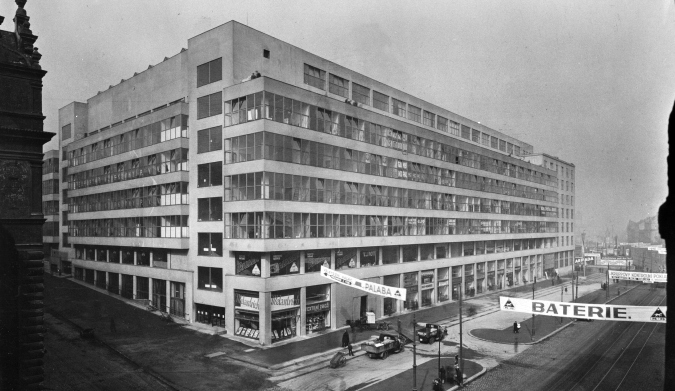
Trade fair era, late 1920s
“The tender called for two structures for commercial and exhibition purposes – one exhibition building with commercial and residential premises and the other with a hotel,” she said. “No information was found regarding who chose the participants, but diversity of architectural style seems to have been one criterion.” She adds the jury who would be choosing the final design were all proponents of the burgeoning functionalism style and the only remaining details they could find on the outcome was from an evaluation published in Stavba magazine.

Small hall, 1930s
“The Prague Trade Fair Palace was a closed competition for select architects. These were A. Dryák, J. Fuchs, E. Kotek, F. Roith, O. Tyl and M. Vaněček. The jury ranked the best designs in this order: O. Tyl, A. Dryák and J. Fuchs, and recommended that the first or the first two together be built or that another competition open to all be held.”
In a second round of voting the jury ultimately chose a design based on both Josef Fuchs and Oldřich Tyl’s proposals. Interestingly from the Stavba review, Tyl’s design got the best review but Fuchs’ was panned.

Small hall after fire, 1974
The building partially opened for its first trade fair in the autumn of 1928, also the 10th anniversary of the Czechoslovak state. Alfons Mucha’s Slav Epic was publically displayed for the first time in the building, so it seems fitting it’s currently on display today as well. While the original ambitious ideas to build a trade fair complex didn’t materialize, the first, and only, building completed did hold trade fairs through World War II. Exhibitions were held on the premises between trade fairs and various companies and publishers had offices there. Some of the original entertainment facilities were realized; there was a cinema with 600 seats in the basement, several restaurants, a rooftop café and a billiards hall.
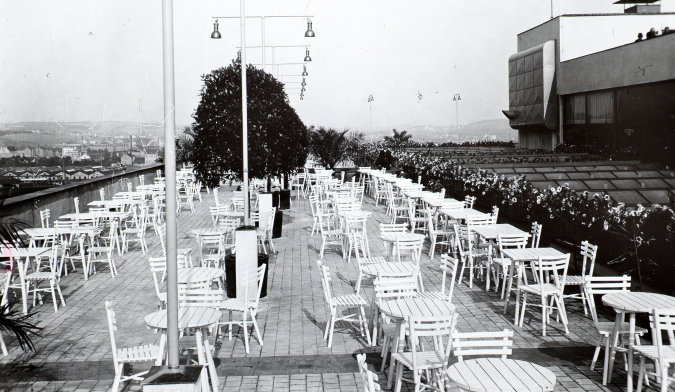
Sixth floor cafe, 1920s
Following the war, few trade fairs were held, with the last one being in 1951. The building became a headquarters for foreign trade companies until August 1974 when a disastrous fire broke out. A few years earlier, the current owner of the building had commissioned a reconstruction project for the Palace which never came to fruition because of the complete destruction wrought by the fire. The companies housed in the building were now homeless and serious consideration was given to demolishing the now remaining skeleton of a structure.
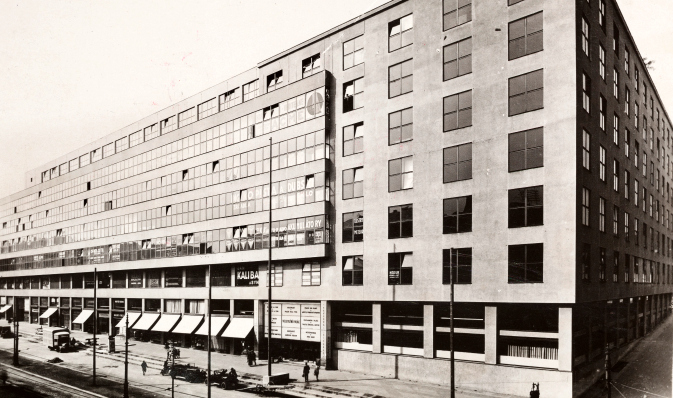
Facade, 1930s
“The building was (loosely included) on the list of heritage sites: only its facade and two halls (courtyards) were protected,” Musilová said. “Architects from Stavoprojekt Liberec spurred a change in the heritage list in 1976, and the new wording protected the entire building. The question of what to do with it, however, remained.”
There were no shortage of suggestions including a hospital, university dormitories, a museum of the workers’ revolutionary movement, the Czechoslovak airlines headquarters, the Czechoslovak Press Agency or a Prague 7 administration building.
“Most (suggestions) showed that very few people really knew the Palace and understood its potential,” Musilová said. “In the meantime, a suggestion was made that the building include a modern art gallery on the balconies of the Small Hall.”
Stavoprojekt Liberec did a usability survey of Veletržní Palace and a transformation into a museum for the National Gallery and its collections of modern and contemporary art turned out to be the best solution.
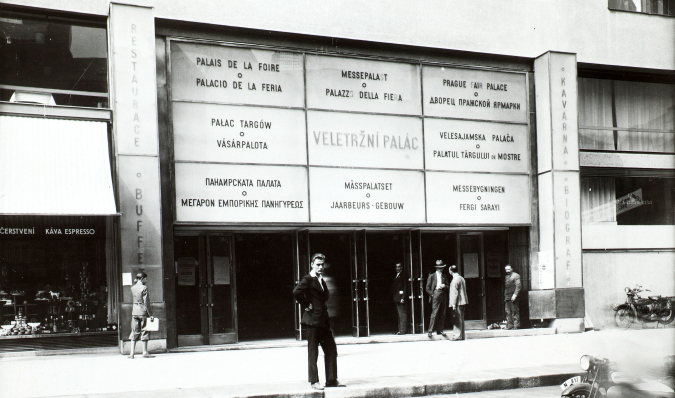
Main entrance, 1930s
“The opinion was that Veletržní Palace should be renovated with maximum respect for its original appearance,” Musilová said. “In the meantime, the National Gallery acquired Veletržní Palace for its collections and the renovations got under way.” This decision though wasn’t made until 1989 with the Palace finally reopening in 1995.
Out of the ashes came new life for the National Gallery, and its exhibition remembering the building shows lots of design sketches and old photos of trade fairs which make the building seem more alive and fuller than it feels today. Be sure to check out the interactive video screen around the corner from the exit (it’s by the railing, I missed it and the guard pointed it out.)
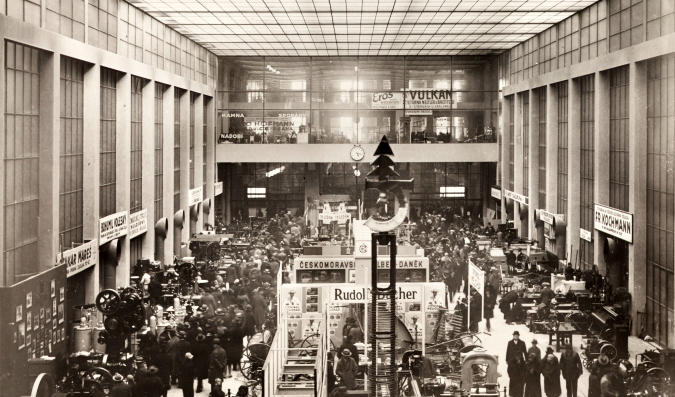
Great Hall during a Trade Fair, 1930s
Musilová said the most interesting discoveries made while putting together the exhibition were connected mainly with the construction.
“The plot is very irregular, it needed special consideration not only architecturally, but mainly in designing the structural stability,” she said. “The plans of every floor are full of irregularities, nevertheless it is not possible to see them in reality.”
Whether you love it for its clean lines and soaring spaces, or think it is a cold hulk of a structure, it’s an important part of Prague’s architectural landscape.
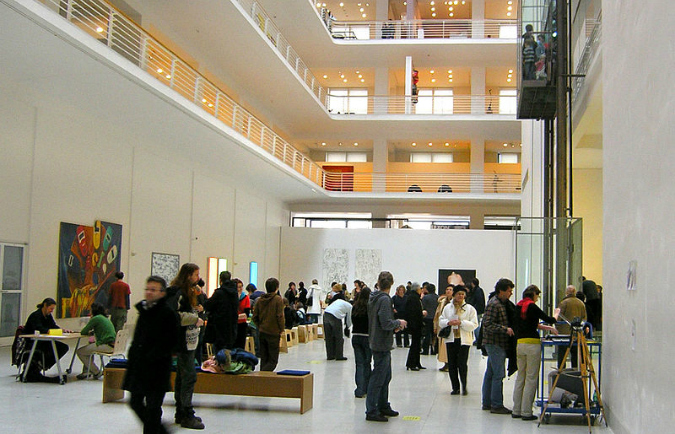
Veletržní Palace today
“Veletržní Palace is one of the most important buildings in the history of modern architecture in the Czech Republic, as far as it is a very early example of a clear functionalistic building,” Musilová said. “Hard to find another building so simple and in the same moment so strong in its expression.”
The Story of the Veletržní Palace
National Gallery, Dukelských hrdinů 47, Prague 7
Through February 8, 2015
**
Veletržní Palace: Eyesore or awesome? Discuss.












 Reading time: 5 minutes
Reading time: 5 minutes 

























